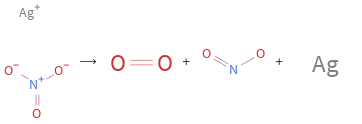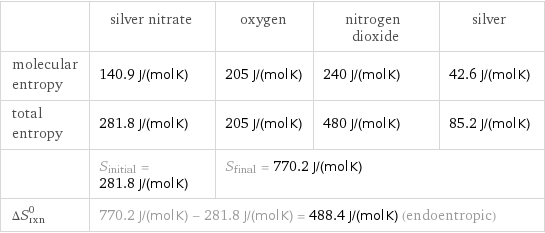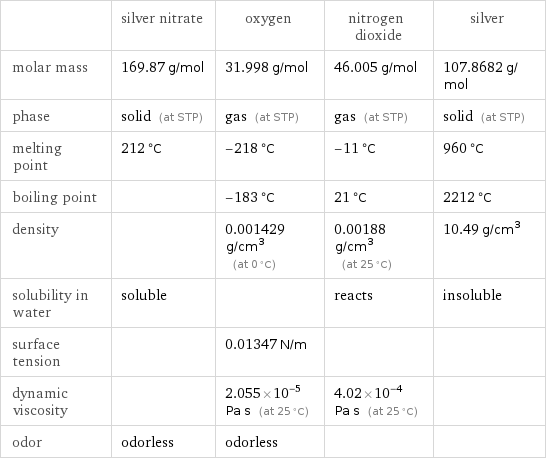Input interpretation

AgNO_3 silver nitrate ⟶ O_2 oxygen + NO_2 nitrogen dioxide + Ag silver
Balanced equation

Balance the chemical equation algebraically: AgNO_3 ⟶ O_2 + NO_2 + Ag Add stoichiometric coefficients, c_i, to the reactants and products: c_1 AgNO_3 ⟶ c_2 O_2 + c_3 NO_2 + c_4 Ag Set the number of atoms in the reactants equal to the number of atoms in the products for Ag, N and O: Ag: | c_1 = c_4 N: | c_1 = c_3 O: | 3 c_1 = 2 c_2 + 2 c_3 Since the coefficients are relative quantities and underdetermined, choose a coefficient to set arbitrarily. To keep the coefficients small, the arbitrary value is ordinarily one. For instance, set c_2 = 1 and solve the system of equations for the remaining coefficients: c_1 = 2 c_2 = 1 c_3 = 2 c_4 = 2 Substitute the coefficients into the chemical reaction to obtain the balanced equation: Answer: | | 2 AgNO_3 ⟶ O_2 + 2 NO_2 + 2 Ag
Structures

⟶ + +
Names

silver nitrate ⟶ oxygen + nitrogen dioxide + silver
Reaction thermodynamics
Enthalpy

| silver nitrate | oxygen | nitrogen dioxide | silver molecular enthalpy | -124.4 kJ/mol | 0 kJ/mol | 33.2 kJ/mol | 0 kJ/mol total enthalpy | -248.8 kJ/mol | 0 kJ/mol | 66.4 kJ/mol | 0 kJ/mol | H_initial = -248.8 kJ/mol | H_final = 66.4 kJ/mol | | ΔH_rxn^0 | 66.4 kJ/mol - -248.8 kJ/mol = 315.2 kJ/mol (endothermic) | | |
Entropy

| silver nitrate | oxygen | nitrogen dioxide | silver molecular entropy | 140.9 J/(mol K) | 205 J/(mol K) | 240 J/(mol K) | 42.6 J/(mol K) total entropy | 281.8 J/(mol K) | 205 J/(mol K) | 480 J/(mol K) | 85.2 J/(mol K) | S_initial = 281.8 J/(mol K) | S_final = 770.2 J/(mol K) | | ΔS_rxn^0 | 770.2 J/(mol K) - 281.8 J/(mol K) = 488.4 J/(mol K) (endoentropic) | | |
Equilibrium constant
![Construct the equilibrium constant, K, expression for: AgNO_3 ⟶ O_2 + NO_2 + Ag Plan: • Balance the chemical equation. • Determine the stoichiometric numbers. • Assemble the activity expression for each chemical species. • Use the activity expressions to build the equilibrium constant expression. Write the balanced chemical equation: 2 AgNO_3 ⟶ O_2 + 2 NO_2 + 2 Ag Assign stoichiometric numbers, ν_i, using the stoichiometric coefficients, c_i, from the balanced chemical equation in the following manner: ν_i = -c_i for reactants and ν_i = c_i for products: chemical species | c_i | ν_i AgNO_3 | 2 | -2 O_2 | 1 | 1 NO_2 | 2 | 2 Ag | 2 | 2 Assemble the activity expressions accounting for the state of matter and ν_i: chemical species | c_i | ν_i | activity expression AgNO_3 | 2 | -2 | ([AgNO3])^(-2) O_2 | 1 | 1 | [O2] NO_2 | 2 | 2 | ([NO2])^2 Ag | 2 | 2 | ([Ag])^2 The equilibrium constant symbol in the concentration basis is: K_c Mulitply the activity expressions to arrive at the K_c expression: Answer: | | K_c = ([AgNO3])^(-2) [O2] ([NO2])^2 ([Ag])^2 = ([O2] ([NO2])^2 ([Ag])^2)/([AgNO3])^2](../image_source/a82ef71c1418fe19839bb70e0833a573.png)
Construct the equilibrium constant, K, expression for: AgNO_3 ⟶ O_2 + NO_2 + Ag Plan: • Balance the chemical equation. • Determine the stoichiometric numbers. • Assemble the activity expression for each chemical species. • Use the activity expressions to build the equilibrium constant expression. Write the balanced chemical equation: 2 AgNO_3 ⟶ O_2 + 2 NO_2 + 2 Ag Assign stoichiometric numbers, ν_i, using the stoichiometric coefficients, c_i, from the balanced chemical equation in the following manner: ν_i = -c_i for reactants and ν_i = c_i for products: chemical species | c_i | ν_i AgNO_3 | 2 | -2 O_2 | 1 | 1 NO_2 | 2 | 2 Ag | 2 | 2 Assemble the activity expressions accounting for the state of matter and ν_i: chemical species | c_i | ν_i | activity expression AgNO_3 | 2 | -2 | ([AgNO3])^(-2) O_2 | 1 | 1 | [O2] NO_2 | 2 | 2 | ([NO2])^2 Ag | 2 | 2 | ([Ag])^2 The equilibrium constant symbol in the concentration basis is: K_c Mulitply the activity expressions to arrive at the K_c expression: Answer: | | K_c = ([AgNO3])^(-2) [O2] ([NO2])^2 ([Ag])^2 = ([O2] ([NO2])^2 ([Ag])^2)/([AgNO3])^2
Rate of reaction
![Construct the rate of reaction expression for: AgNO_3 ⟶ O_2 + NO_2 + Ag Plan: • Balance the chemical equation. • Determine the stoichiometric numbers. • Assemble the rate term for each chemical species. • Write the rate of reaction expression. Write the balanced chemical equation: 2 AgNO_3 ⟶ O_2 + 2 NO_2 + 2 Ag Assign stoichiometric numbers, ν_i, using the stoichiometric coefficients, c_i, from the balanced chemical equation in the following manner: ν_i = -c_i for reactants and ν_i = c_i for products: chemical species | c_i | ν_i AgNO_3 | 2 | -2 O_2 | 1 | 1 NO_2 | 2 | 2 Ag | 2 | 2 The rate term for each chemical species, B_i, is 1/ν_i(Δ[B_i])/(Δt) where [B_i] is the amount concentration and t is time: chemical species | c_i | ν_i | rate term AgNO_3 | 2 | -2 | -1/2 (Δ[AgNO3])/(Δt) O_2 | 1 | 1 | (Δ[O2])/(Δt) NO_2 | 2 | 2 | 1/2 (Δ[NO2])/(Δt) Ag | 2 | 2 | 1/2 (Δ[Ag])/(Δt) (for infinitesimal rate of change, replace Δ with d) Set the rate terms equal to each other to arrive at the rate expression: Answer: | | rate = -1/2 (Δ[AgNO3])/(Δt) = (Δ[O2])/(Δt) = 1/2 (Δ[NO2])/(Δt) = 1/2 (Δ[Ag])/(Δt) (assuming constant volume and no accumulation of intermediates or side products)](../image_source/4e058180cb301e634b6b5de16636fb13.png)
Construct the rate of reaction expression for: AgNO_3 ⟶ O_2 + NO_2 + Ag Plan: • Balance the chemical equation. • Determine the stoichiometric numbers. • Assemble the rate term for each chemical species. • Write the rate of reaction expression. Write the balanced chemical equation: 2 AgNO_3 ⟶ O_2 + 2 NO_2 + 2 Ag Assign stoichiometric numbers, ν_i, using the stoichiometric coefficients, c_i, from the balanced chemical equation in the following manner: ν_i = -c_i for reactants and ν_i = c_i for products: chemical species | c_i | ν_i AgNO_3 | 2 | -2 O_2 | 1 | 1 NO_2 | 2 | 2 Ag | 2 | 2 The rate term for each chemical species, B_i, is 1/ν_i(Δ[B_i])/(Δt) where [B_i] is the amount concentration and t is time: chemical species | c_i | ν_i | rate term AgNO_3 | 2 | -2 | -1/2 (Δ[AgNO3])/(Δt) O_2 | 1 | 1 | (Δ[O2])/(Δt) NO_2 | 2 | 2 | 1/2 (Δ[NO2])/(Δt) Ag | 2 | 2 | 1/2 (Δ[Ag])/(Δt) (for infinitesimal rate of change, replace Δ with d) Set the rate terms equal to each other to arrive at the rate expression: Answer: | | rate = -1/2 (Δ[AgNO3])/(Δt) = (Δ[O2])/(Δt) = 1/2 (Δ[NO2])/(Δt) = 1/2 (Δ[Ag])/(Δt) (assuming constant volume and no accumulation of intermediates or side products)
Chemical names and formulas

| silver nitrate | oxygen | nitrogen dioxide | silver formula | AgNO_3 | O_2 | NO_2 | Ag name | silver nitrate | oxygen | nitrogen dioxide | silver IUPAC name | silver nitrate | molecular oxygen | Nitrogen dioxide | silver
Substance properties

| silver nitrate | oxygen | nitrogen dioxide | silver molar mass | 169.87 g/mol | 31.998 g/mol | 46.005 g/mol | 107.8682 g/mol phase | solid (at STP) | gas (at STP) | gas (at STP) | solid (at STP) melting point | 212 °C | -218 °C | -11 °C | 960 °C boiling point | | -183 °C | 21 °C | 2212 °C density | | 0.001429 g/cm^3 (at 0 °C) | 0.00188 g/cm^3 (at 25 °C) | 10.49 g/cm^3 solubility in water | soluble | | reacts | insoluble surface tension | | 0.01347 N/m | | dynamic viscosity | | 2.055×10^-5 Pa s (at 25 °C) | 4.02×10^-4 Pa s (at 25 °C) | odor | odorless | odorless | |
Units
